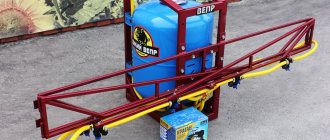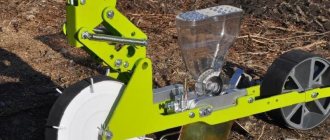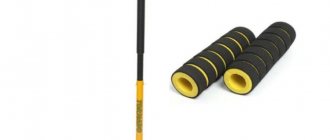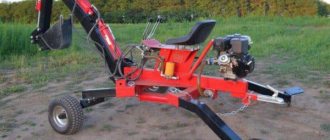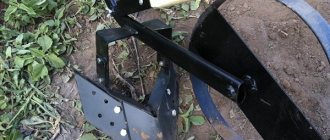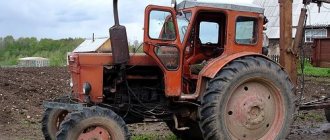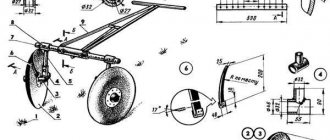Every experienced gardener and gardener knows that it is impossible to do without a garden sprayer. With the onset of spring, fruit trees, berry bushes and vegetable beds are attacked by dozens of insect pests. Plants are also susceptible to all kinds of infectious and fungal diseases.
You can save the harvest and help the plants only by carefully treating the stems and leaves. In this case, the preparations should be sprayed in a sufficiently dense stream. This saves the budget and at the same time is quite effective processing. The sprayer is also useful for applying root fertilizers to the soil.
Sprayer design
The most common and reliable are manual sprayers. They are easy to use, reliable and affordable for any summer resident.
The sprayer is a container made of plastic and equipped with a lid with a pump for pressurizing. The pump sprays liquid through the sprayer nozzles when the handle is pressed - the valve opens. There is also an air release valve and a fluid control scale. All models have nozzles protected by filters to prevent clogging. After use, the tank must be washed with water - the remaining working solution can crystallize and clog the narrow holes of the nozzle and filter cells.
The classic sprayer is a compact device with a capacity of 0.5 to 2 liters. It has a side handle - it is convenient to hold the device with one hand, and a small spout for spraying. Pressure is built up by a pump on the lid. Spraying occurs by pressing a button or lever on the handle. The nozzle easily regulates the water flow. You can install a fine spray or a powerful jet.
Injectors are often made of plastic. More expensive models have brass ones.
Possibility of self-production
You can buy a pump sprayer in specialized stores. There is also the opportunity to make the device yourself at home. The advantage of a home-made unit is that it is possible to save money, as well as create just such a model that will fully meet the user’s requirements.
Before starting work, it is recommended to prepare all the necessary materials and tools:
- plastic tank;
- automobile nipple and compressor;
- spray tip;
- hoses.
In order to make a sprayer with your own hands, it is recommended to follow the following sequence of actions:
- Drill holes in the plastic tank.
- Insert the car nipple into them.
- Connect the compressor.
- Seal all openings using special sealant.
You should also pay attention to the use of PVC hoses. This will ensure that the liquid can be sprayed effectively.
The presence of a pump sprayer in the household of every gardener increases the likelihood of getting a good harvest in the future.
Types of sprayers
For convenience when processing large areas, two main types of sprayers are available.
Pump-action
The pump type is a garden sprayer with a special strap for carrying on one shoulder. The capacity of such sprayers is from 3 to 12 liters. A pump is built into the cover, with
with the help of which pressure is pumped up to three or four atmospheres. A 1-1.5 meter long hose is attached to the bottom of the tank, which turns into a metal tube with nozzles at the end. At the top of the tube there is a handle and lever to activate the spray. For long-term operation there is a shutter button with which you can leave the sprayer on. This will take the stress off the hand and finger holding the power lever. When the pressure drops, it must be pumped up and work continued.
Advantages:
- ease of use;
- you can process up to 30 acres at a time;
- durability.
Flaws:
- quite high price (average price category - 30-35 dollars);
- large weight together with the filled working solution.
Backpack
The backpack type is a garden sprayer with two straps for carrying on the back.
An additional belt secures the device to your belt so you can lean forward without fear. Pressure builds up not in the tank, but directly in the pump chamber. Switching on is carried out by pressing the handle located on the side of the tank. The solution flows through a 1.5 meter long hose and a metal tube to the nozzles. Tank capacity from 12 to 20 liters.
It is possible to install the handle on both sides (for left-handed or right-handed people). Between the tank and the handle there must be a backing material (plastic part) to protect the tank from damage by the handle.
Advantages:
- you can process up to 50 acres in one refill;
- no need to stop to build up pressure;
- Some models have a repair kit.
Flaws:
- high price (average $50);
- constant pumping of pressure is required;
- The handle is not securely attached to the body.
How to do it yourself
Let's look at how you can design a battery sprayer. To make it, you need to take a tank - an old pump sprayer with a broken pump that cannot be repaired is perfect. It is extremely important that there is a sealed tank, working rod and air valve.
You will also need a battery (12 V) and a car compressor. You need to drill a hole in the container and insert a car nipple to which the compressor is connected. To seal the hole under the washers, you can lay a rubber gasket or blow it with sealant. Then the compressor must be connected to the battery.
Thanks to the high pressure in the tank, the spray is very fine. The required pressure is pumped up, and the excess is released through the valve. The undeniable advantage of a self-designed battery sprayer is the ability to repair and replace any element. When working with any sprayer, you should remember to follow safety rules: protective clothing, use gloves, a respirator, and a hat. At the end of work, the device should be disassembled and thoroughly washed with water, then dried and reassembled.
Model overview
Hozelock Pro 4810
The Hozelock Pro 4810 is made in the UK. This is a convenient pump-type sprayer with a ten-liter tank. Has seals that are resistant to acid and alkaline solutions. The maximum filling level of the tank is 8 liters.
Peculiarities:
- A nozzle with the ability to regulate the flow from a fine spray (cloud) to a jet. The spout is made of nickel-plated brass, the pump is metal.
- There is a lock button in spray mode.
- A release valve is provided to regulate the pressure.
- A telescopic tube (50-85 centimeters) provides convenient access to all parts of the plant.
- The belt can be attached in three ways - it can be worn on the shoulder, over the shoulder or on the back, which makes it easier to use the sprayer.
- The tank is transparent with a scale that allows you to easily control the amount of solution, and a wide neck.
- The kit includes a measuring container with a solution indicator (you can determine what was poured last - insecticide, fertilizer or herbicide), a cone for spraying herbicides and an integrated compartment for storing the tube and other parts of the device.
The average cost is 3,929 rubles (Moscow).
Reviews:
- Purchased last year. The sprayer is easy to use. The long tube allows you to keep your distance from chemicals (they are all classified as hazardous to humans).
- I was pleased with the transparent tank - everything is visible! The plastic tank of the old sprayer was colored, and the solution was almost invisible through it.
- High quality unit. The metal pump and nozzle are especially good. They provide a 5 year warranty. The price, of course, is considerable. But other models in this series have even higher prices. We pay for reliability.
"Lemira" OP-202-01
"Lemira" OP-202-01 is produced by a Ukrainian manufacturer from the city of Dnepropetrovsk. This is a budget pump-type sprayer with a ten-liter tank. The maximum tank filling level is eight liters.
Peculiarities:
- The sprayer has a flexible hose 1.3 meters long with a telescopic tube (0.75 -1 meter). The nozzle allows you to adjust the flow power from fine spray to jet. The belt can be worn on one shoulder.
- The sprayer is quite light, made of plastic - weighs 3 kilograms (without working solution).
- The lid has a pressure indicator with a valve for bleeding air.
- The device is declared by the manufacturer as universal, suitable for disinfestation, washing cars and windows.
The average cost is 722 rubles.
Reviews:
- Very light sprayer. Comfortable in using. The main thing is to check all connections before work so that the solution does not leak.
- The price of imported sprayers forced me to buy Lemira. Perhaps the European models are made better and will last longer, but the Ukrainian version of the sprayer turned out to be not so bad. One year warranty. You can buy spare parts without any problems. Everything is available.
- We found no shortcomings. The jet is easily adjustable. It hits almost two meters. We liked the fine spray, it covers the area better when processing. The price is very affordable!
The leaf moth is a small butterfly that feeds on the leaves of fruit trees, causing great damage to the garden. Moths are a numerous species of harmful insects that live both in the forest and in the garden. You can find out why these butterflies are harmful here.
Sweet clover is an excellent melliferous and forage plant that is loved by many pests. You can find out which ones by following the link.
Choosing a sprayer for the garden
Quite often, enterprising gardeners assemble sprayers themselves. In fact, making a high-quality sprayer on your own is not such a difficult task. By making a good homemade device, you can save yourself from regular sprayer repairs and provide effective care for your green spaces. Which option is more rational - buying a good sprayer or making it yourself? Let's figure it out together.
As you might guess, the main function of sprayers is to spray special chemical compounds (stimulating, fertilizing, etc.) on plants in an appropriate manner. Preparations applied in this way adhere perfectly to bushes and trees, and can exhibit their beneficial properties for a long time. Fruit trees and some types of bushes should be sprayed without fail, this is the only way to provide them with effective protection from various pests and diseases (mites, aphids, worms and others).
Tips for choosing a sprayer
The main thing in any sprayer is the tank capacity.
To choose the right one, you need to focus on the following indicators:
- to process 10 square meters of beds you will need one or two liters of working solution; a young tree needs two to three liters;
- a large tree is sprayed with ten liters of solution.
For a small flowerbed or bed, a 2-liter model is suitable, and for gardening you can’t do without a more capacious sprayer with a capacity of ten to twelve liters.
- The transparency of the tank and the presence of a graduated scale are a mandatory attribute of a quality device.
- The weight of an empty 10 liter sprayer is on average three kilograms. For processing small beds, compact models for carrying on the shoulder with a maximum capacity of 6 liters are suitable.
- The design is taken into account depending on the physical data and processing area. The backpack type requires constant pressure pumping, which is tiring for the hands. It is more convenient to carry such a sprayer, and the tank capacity will allow you to treat a large tree or 50 acres of vegetable garden. The pump type is not so comfortable to wear - one shoulder is involved, and it can cover an area of 20 hundredths, but it is lighter and can be removed fairly quickly.
- The optimal length of the tube (rod) is 1-1.5 meters. The telescopic design makes it easy to store and carry the sprayer.
- When purchasing, you must carefully check the package (including spare parts) and inspect the sprayer. All components must be made with high quality. This is especially true for the safety valve and pump.
Classification according to the method of creating working fluid pressure
Motorized sprayers
The most powerful garden sprayers are motorized sprayers; atomization occurs under the pressure of a stream of air created by a diaphragm-type pump driven by a small engine, usually a gasoline engine.
Membrane type
A membrane-type pump (diaphragm, diaphragm pump) is a volumetric pump, where the working body is a flexible plate fixed at the edges. Under the influence of some mechanism or force, the plate bends, performing the function of a piston pushing the working fluid.
Electric backpack
A slightly less powerful class is the electric backpack garden sprayer. The diaphragm type pump receives energy from a 12 volt battery.
Due to its optimal power and size, this sprayer has received wide recognition and is often used not only for its intended purpose; and, for example, for washing windows or as a sprayer during construction and renovation. You can also make a foam generator for washing with your own hands. The working fluid is located in a backpack container behind the operator’s back.
Materials:
- glue PVC pipes 20 mm, 32 mm;
- plug 32 mm;
- coupling 32 mm;
- coupling 20 mm;
- plugs 20 mm – 3 pcs.;
- elbows 20 mm – 2 pcs.;
- tees 20 mm – 2 pcs.;
- copper pipe 9 mm;
- glue for PVC pipes.
Full cone spray
Spraying with a “full cone” spray is achieved using a swirler, which shapes its flow in a certain way before the liquid leaves the nozzle. Full cone spraying produces a round, square, rectangular or oval spray pattern that is completely covered in liquid stains. Nozzles of this type irrigate the entire surface of the circle.
A distinctive feature of full cone spraying is that irrigation occurs extremely evenly, but the size of the droplets in this case is larger than with hollow cone nozzles.
Potato digger for walk-behind tractor
Potato diggers of various types are very popular among farmers. These devices save people from hard manual labor, speeding up the harvesting process several times. The walk-behind tractor has a very simple design. It can be made from metal that remains after the construction and renovation of a house.
To work you will need:
- Bulgarian;
- welding machine;
- electric drill;
- heavy hammer;
- anvil;
- profile steel pipe 20x40 mm;
- reinforcement 12 mm;
- tin (preferably stainless);
- bayonet shovel without handle.
The attachment to the walk-behind tractor is made in a suspended or trailed (modular) design. The hanging tool only digs up the tubers, leaving them lying on the surface for subsequent manual harvesting. A modular potato digger not only extracts the crop from the ground, but also collects it in a mobile container on a chassis.
The manufacture of a digger is carried out in the following sequence:
- Drawing up a drawing. The width of the digger should be within 25-30 cm. The angle of attack of the tip is taken perpendicular to the coulter so that the tool does not bury itself in the ground.
- The reinforcement is cut into fragments of a given length. Using a hammer and anvil, they are given the required bend.
- A container for tubers is assembled from a profile pipe and tin. The chassis or skids are welded to the container frame. The runners are made from pipes, and the chassis is taken from an old stroller, cart or lawn mower.
- The holder and reinforcement bars are welded to the shovel. A drawbar is welded to the holder, which is fixed to the assembly container. Connections are made movable using bolts or hinges.
- Rust and weld marks are removed. The finished product is treated with an anti-corrosion agent and coated with paint.
Adjustment and adjustment of the digger is carried out using racks and steel ties.
Included with the digger, you can immediately make a disk hiller. This tool will be needed when planting tubers after they have been buried in a trench made by a plow. Hillers are made from old pot lids, profile pipes and bolts. A trolley is assembled from pipes and small wheels, onto which holders for lids are welded at a certain angle. After sharpening on a stone, the discs are mounted on holders.
Holder
You can make a holder for the spray bottle. For this you need a board 10 mm thick. A square 250 x 250 mm is cut out of plywood or wood. A hole in the shape of a circle is cut out in it with a jigsaw. It must match the paint tank of the unit. The pistol handle is inserted into the groove. It is cut out from the edge of the plywood to the hole. The structure must be installed on a support of 3-4 legs.
Having considered the options for creating a spray bottle with your own hands, you can design a suitable type of structure. This will allow you to apply paint and whitewash quickly and efficiently.
Source
Regular pen
How to make a spray bottle with your own hands? There are several options for such designs. One of the easiest ways is to use a ballpoint pen. This is the most primitive design. You can assemble it in just 30 minutes.
The operating principle of such a device is simple. A man blows into the tube of the pen body. Splashes of paint burst out through it on the other side. The material must be blown with high intensity. If you do this half-heartedly, the drops of paint will not spread evenly over the surface. You can practice before starting work.
To make such a spray gun, you will need to purchase:
A small bottle can be used as a container. It must have a lid. It is better to prepare not one, but several needles. They may break during operation of the device.
Are you here
Questions can only be asked after registration. Please login or register.
After reading the forums, I decided and created a sprayer towed to a walk-behind tractor adapter. The drive is independent - a motor pump. The distance is 4 meters. I cultivated 60 acres of land without any problems.
describe in more detail if possible send a photo
It turned out to be a cool console, I admire it.
More details please, otherwise what’s the point of posting it on the forum.
The author created intrigue and disappeared
The author created intrigue and disappeared
Yeah, such a thing is necessary, but he doesn’t want to tell. Please respond, many will be grateful.
The author created intrigue and disappeared
We looked, and now we need to think. The most important thing is the IDEA.
Good day, here is my idea. Barrel 300 l (stainless steel). The used NSh-32 pump pumps 6-12 atm. Coarse and fine filter. Pressure reducer 3 atm on the rods. Excessive pressure through the valve by 3 atm back into the barrel to stir the solution. Sprayers and hoses from Polish manufacturers. each with a filter inside. Height-adjustable rod. Width 6m. Consumption 170l per 50 acres. Productivity 1 ha per hour. See walk-behind tractor and sprayer. https://www.youtube.com/watch?v=6WOhfHQruU0&feature=related https://www.youtube.com/watch?v=q8H5qnCzLc8&feature=mfu_in_order&list=UL . Files: zobrazhennya0899.jpg zobrazhennya0897.jpg zobrazhennya0882.jpg zobrazhennya0863.jpg zobrazhennya0868.jpg zobrazhennya0860.jpg
Test. Except as a unidirectional radial force on the pump bushings through the belt. If the speed matches, then it is better to connect the pump to the intermediate shaft with an ordinary rubber dense hose. For repeaters on the MB1 experience - I screwed the pump onto the steering wheel (the platform for welding the steering tubes) and spun from a pulley attached to the large MB pulley. THOSE. The pump starts spinning when you drive. To get there, turn off the speed. The inconveniences are minimal, but it is easier to manufacture.
“sow the reasonable, the good, the eternal.” (Nekrasov N.) Arnold Grinshtat. Move correctly and you will be healthy.
Alexander M Give me photos. it’s not clear on the fingers.
Alexander M Give me photos. it’s not clear on the fingers.
There was one lying around. In the morning I tried to send, but the megaphone for outgoing traffic was lousy - I ripped off the money, but did not send. I will answer specific questions.
“sow the reasonable, the good, the eternal.” (Nekrasov N.) Arnold Grinshtat. Move correctly and you will be healthy.
and what -NSH- will pump water and for how long.
Good health to you Nikolai Palych! I was scouring the internet for a sprayer for a walk-behind tractor, I came across your video and liked it. Hence a couple of questions. If it’s not secret, the parameters of your motor pump, I was also leaning towards this option, but since I can’t imagine what pressure is needed for good spray? Secondly, what are your sprayers from? Or what can make them slobber on?
how to make a filter yourself, or where to supply it
?
I started doing this too. Files: foto-0205.jpg
would be cool to do
. If it’s not secret, the parameters of your motor pump, I was also leaning towards this option, but since I can’t imagine what pressure is needed for good spray? Secondly, what are your sprayers from? Or what can make them slobber on?
the video is not mine, I found it on the Internet, but it completely shows the idea that I wanted to implement))) the water pump is the simplest Chinese one - believe me, it is enough and sprayers (nozzles) are sold in an agricultural equipment store, I took 20 pieces, there are 3 positions, but I took it for one, after calculating the volumes I still took the Bomet sprayer for 12 meters
Thank you very much for your answer. About the injectors. I have never seen them in person and don’t even have an idea. Question: Garden stores sell crevice spray nozzles for water pipes, are they suitable?
Question: Garden stores sell crevice spray nozzles for water pipes, are they suitable?
you need to visit a store that sells spare parts for agricultural machinery
Thank you Nikolay Palych for your answers. Happy holiday to YOU. Just no matter how much I walked around Irkutsk, I didn’t come across such things. I found on the net that the price seemed normal, something like 200 rubles, but there the calculated pressure was 4 points, so I began to think that the Chinese one would squeeze out that much. And we sell different motor pumps, mostly 6 meters, lift 30 columns, 30 cubic meters per hour, plus or minus, not a big takeoff.
Advantages of irrigation systems
Artificial “rain” from a sprayer has a beneficial effect on the growth of agricultural crops. After scattered watering, a crust does not form on the soil surface and there is no need to loosen the soil. Gradual moistening does not erode the soil near the roots of plants; therefore, finely dispersed watering promotes better and faster growth of irrigated crops. Dripping water onto the leaves and stems of plants stimulates their active growth.
The modern gardening market offers a huge selection of water sprinklers for watering your garden or lawn. But for a small garden plot it is not at all necessary to purchase an expensive sprayer. Even a novice gardener can make an effective spray bottle from scrap materials that is not inferior in watering quality to factory-made analogues.
Spraying with a “full, solid jet” torch
Spraying with a “full, solid jet” torch is a continuous stream of liquid coming out of the hole. In this case, no spraying occurs at all, since the liquid, combined into one stream, forms one single, focused jet of maximum strength.
The design of the nozzles helps prevent the formation of turbulence inside the nozzle body, which, in turn, prevents the liquid from disintegrating into droplets at the maximum extent of the jet. As a result of this, the jet, leaving the nozzle, retains its shape and continuity over large stretches, and hence the high impact force on the surface.
Lechler all-jet nozzles are used in intensive cleaning processes, water jet cutting, edge cutting, loosening or washing away sludge and bottom sediments, that is, where a targeted water jet with maximum impact force is required.
Homemade variator for walk-behind tractor
The variator allows you to smoothly change speed without sudden jerks, saves fuel by transmitting torque. Motors from a walk-behind tractor are often used as a generator to provide electricity to living quarters, local areas, and also to operate lathes.
A homemade variator can be made in different ways, the easiest way is to use a ready-made variator, which can be converted for a specific walk-behind tractor. Another way is to use ready-made parts from gearboxes and other mechanisms. You can also make parts yourself, provided you have special equipment (discs require hot stamping). Diagrams and videos for creating parts and assembling pulleys are easy to find on the Internet.
You can make a variator from wheel hubs, the main thing is to make a hole diameter suitable for the crankshaft. In addition to pulleys, a variator requires a belt, which is one of the most important parts. The belt must be strong, and all parts of the variator must be lubricated regularly.

